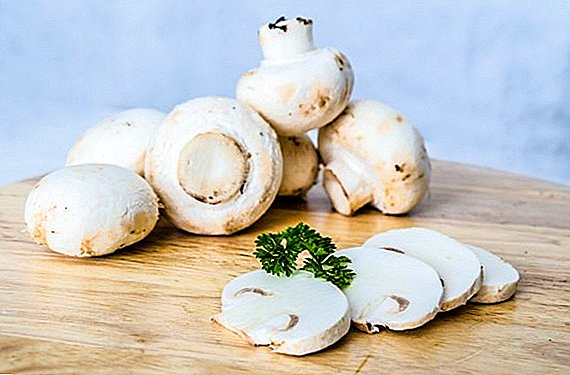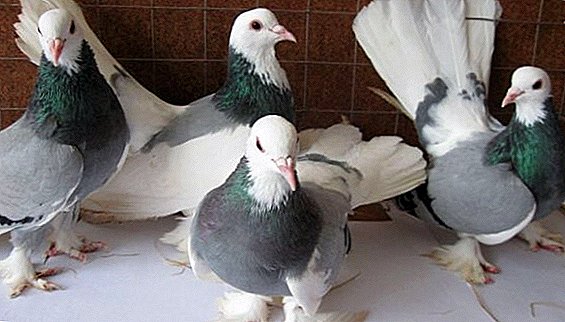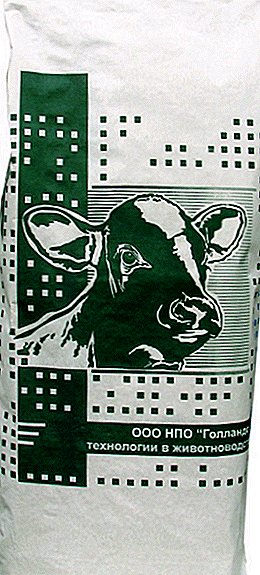 The richest and abundant feed in the form of succulent herbs provide the productivity of cattle to a certain limit, after which it ceases to grow. To overcome this barrier, livestock breeders have come up with premixes, which will be discussed further.
The richest and abundant feed in the form of succulent herbs provide the productivity of cattle to a certain limit, after which it ceases to grow. To overcome this barrier, livestock breeders have come up with premixes, which will be discussed further.
What is and why do we need premixes for cattle?
Highly productive cows, giving up to 6 tons of milk during the lactation period, together with it produce up to 220 kg of protein, up to 300 kg of fat, the same amount of sugar, about 9 kg of calcium, up to 7 kg of phosphorus and a large amount of vitamins, micro and macronutrients. That is, the metabolic processes in the animal's body are functioning at full capacity and need timely and full-fledged feeding.
Did you know? Cows and bulls have almost panoramic vision, thanks to which they are able to simultaneously observe the surroundings almost 360 degrees. This helps them rectangular pupils.
Meanwhile, conventional cattle feeds in the form of green grass, hay, wheat, rye and oats, partially covering the animal’s body’s need for substances necessary for its functioning, cannot provide it with biologically active nutrients to the extent that could lead to a noticeable increase in milk production. and meat productivity of livestock.
This problem is solved by premixes, which are homogeneous powdery sets of biologically active substances on the basis of fillers in the form:
- shrots;
- fodder yeast;
- wheat bran;
- chalk;
- Cormolysin;
- bone meal.
 Themselves biologically active additives currently there are more than a hundred.
Themselves biologically active additives currently there are more than a hundred.And the vast majority of them contain vitamins:
- BUT;
- group B;
- WITH;
- D3;
- TO.
Find out more about cattle feed additives.
Also included in the premix are macro and micronutrients:
- iron;
- iodine;
- copper;
- manganese;
- magnesium;
- cobalt;
- selenium;
- potassium;
- calcium.
In addition, almost all premixes are supplied with antioxidants and food antibiotics that strengthen the immune system of animals and prevent diseases.  Depending on the target orientation, premixes are divided into species that are aimed at:
Depending on the target orientation, premixes are divided into species that are aimed at:
- An increase in milk production, for which supplements are saturated with amino acids, lactic acid bacteria and humic acids, which improve the microflora of the bovine stomach, accelerate the digestive process and strengthen the immune system.
- The removal from the body of animals of harmful substances that are used in the cultivation of cereals and enter the body along with the grain. These additives have good absorbent properties.
- Successful fattening of calves, for which premixes are saturated with vitamins A, B, D, E, K, as well as with micro and macro elements in the form of iodine, iron, selenium, magnesium, cobalt and some others, which stimulate the growth of calves.
- Treatment of specific animal diseases, for which they are supplied with appropriate drugs.
We advise you to read about how to properly fatten cattle.
The benefits of using them
The use of a mixture of dietary supplements gives breeders tangible benefits:
- increase in livestock productivity by an average of 12-15%;
- accelerating calf growth;
- improved food absorption;
- the formation of healthy microflora in the gastrointestinal tract;
- immunity strengthening;
- optimization of the feeding process;
- significant reduction in feed consumption;
- reduction of costs for medicinal products and veterinary services.

How to apply: basic rules
As a rule, premixes are added to the fillers immediately before feeding the livestock, most often once a day, in the morning.
It will be useful for you to read about why cows are given salt, whether it is possible to give potatoes to a milk cow, and also learn how to give cows fodder yeast, silage and beet pulp.
However, there is no universal way to use dietary supplements for all occasions, since there are rules for their use, which take into account various factors for the use of premixes - up to economic ones:
- It makes no sense to use premixes for winter livestock during the winter period of livestock maintenance.
- The use of universal premixes is always unnecessarily expensive, since such supplements contain useful substances "with a reserve".
- When choosing suitable dietary supplements, one should take into account not only the sex and age of the livestock, but also its physiological state, region of stay, as well as the nutritional value of the feed and its saturation with nutrients in each specific farm.
Dry cows require a special approach to their diet, which significantly accelerates mineral metabolism in the body.  For the needs of the emerging fetus, the cow needs more:
For the needs of the emerging fetus, the cow needs more:
- calcium;
- sodium;
- phosphorus;
- cobalt;
- copper;
- iodine;
- manganese.
In addition to these and other micro-and macro-elements, the body of a dry cow requires an increased amount of such vitamins:
- BUT;
- D;
- E.
Important! For example, dry cows prone to paresis should not include calcium and salt in their supplements.The animals need carotene during this period. It follows from this that it is necessary to give premixed cows to the dry-standing cows, selecting the composition of additives in each specific case individually.

Premixes for cows: composition, method of administration, dosage
As already emphasized, today there are more than one hundred types of dietary supplements, for the use of which there are specific conditions, doses, norms, methods and objects of use. Let's look at how this looks with examples of the most popular premix for cattle.
"Burenka"
This premix contains minerals in the form:
- copper;
- manganese;
- cobalt;
- iodine;
- zinc.
- BUT;
- D3;
- E.
 The “Burenka” packaged in three-gram packages is mixed with the same amount of wheat flour in dry form and is added to the feed in the morning in accordance with the following consumption rates:
The “Burenka” packaged in three-gram packages is mixed with the same amount of wheat flour in dry form and is added to the feed in the morning in accordance with the following consumption rates:| Animal groups | Daily dose on 1 head, g |
| milk cows | 55-60 |
| dry cows | 35-40 |
| heifers | 30-35 |
| manufacturing bulls | 45-50 |
Important! You cannot add premix to hot food.
Dolphos B
These popular supplements contain vitamins:
- BUT;
- IN 1;
- AT 2;
- AT 6;
- AT 12;
- D;
- E;
- TO.
 Also, they contain micro and macro elements in the form:
Also, they contain micro and macro elements in the form:- calcium;
- phosphorus;
- magnesium;
- zinc;
- gland;
- sodium;
- manganese;
- cobalt;
- copper;
- Selena;
- iodine.
Considered supplements are added in the morning to feed using the following rates of consumption in the pasture period:
| Animal groups | Daily dose on 1 head, g |
| milk cows | 50-70 |
| dry cows | 30-50 |
| heifers | 20-40 |
| manufacturing bulls | 20-50 |
 And in the winter period, the consumption rates of additives are as follows:
And in the winter period, the consumption rates of additives are as follows:| Animal groups | Daily dose on 1 head, g |
| milk cows | 80-100 |
| dry cows | 60-80 |
| heifers | 50-70 |
| manufacturing bulls | 50-80 |
"Miracle" for fattening calves
This premix is focused on the enrichment of calf food and the prevention of diseases associated with a deficiency in their bodies:
- phosphorus;
- calcium;
- copper;
- iodine;
- cobalt.
We recommend reading about how to properly feed calves for rapid growth.
Supplements also eliminate the lack of calves in the body of vitamins A and D, thereby preventing rickets.  The tool is added to the calf feed in the morning, based on the following standards, which depend on the weight of the individual:
The tool is added to the calf feed in the morning, based on the following standards, which depend on the weight of the individual:
| Calves weight, kg | Daily dose on 1 head, g |
| 150 | 15 |
| 200 | 20 |
| 250 | 25 |
| 300 | 30 |
| 350 | 35 |
Experts have for sure established that even if the farm has the most highly productive dairy breeds of cows and plenty of food for them without the use of premixes, which provide animals with the optimal amount of vitamins and minerals, you should not count on milk yield exceeding 20 liters per day.
Did you know The metabolism of the dairy cow is so intense that the animal has to eat more than 45 kilograms of feed and drink about 180 liters of water every day.Therefore, it is important to choose the right supplements for your animals and apply them correctly.












